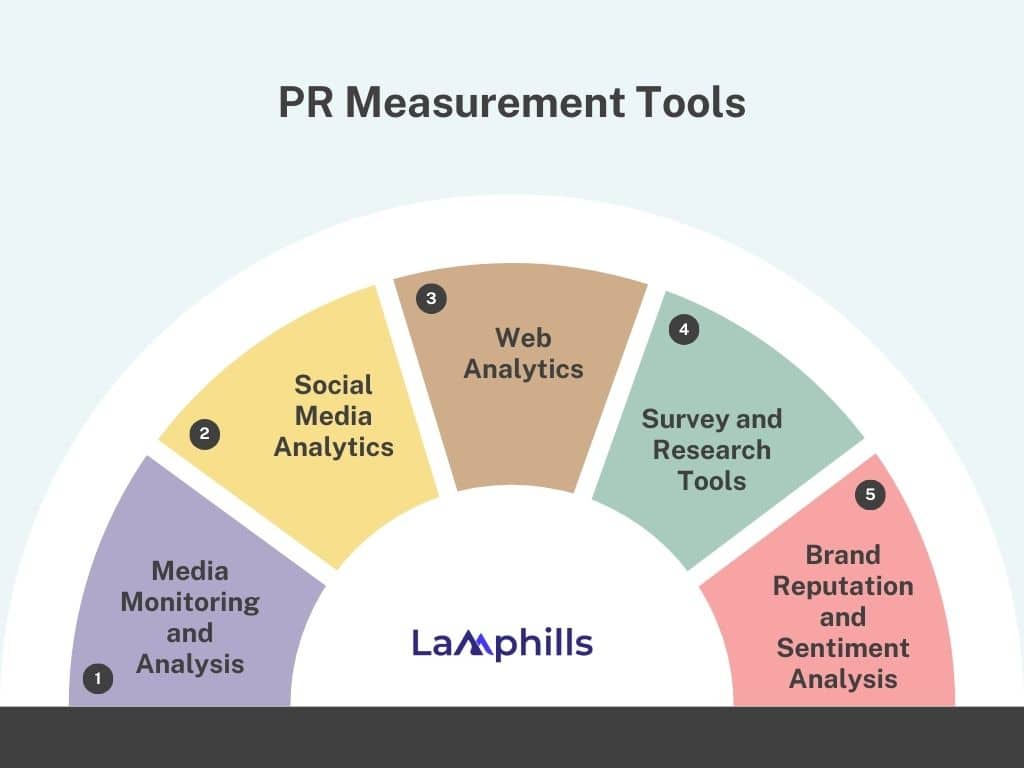Measuring the effectiveness of your PR efforts is necessary for demonstrating value, guiding strategy, and driving continuous improvement. Working as a digital marketer exposed me to the complexities of PR measurement in various industries, and I’ve come to appreciate its transformative power. PR measurement isn’t just about numbers; it’s about turning creative efforts into strategic assets that align with business goals. Drawing from my experiences and insights from successful campaigns, this guide will walk you through proven strategies and tools to effectively measure and enhance your PR initiatives. Whether you’re looking to assess media coverage, gauge audience engagement, or correlate PR activities with business outcomes, you’ll find practical advice and expert tips to elevate your PR game and deliver tangible results.
Key Points
- PR measurement is all about assessing the effectiveness and impact of your public relations efforts. It’s more like assessing your ROI after a business season.
- It isn’t just about numbers; it’s about turning creative efforts into strategic assets that align with business goals.
- PR measurement helps us ascertain whether our campaign yields the expected results.
- Measuring the results of your PR campaign helps you understand its impact, demonstrate its value, make strategic decisions, drive continuous improvement, enhance credibility, and set benchmarks.
- Various tools and technologies are available to help measure PR performance and track relevant metrics. These tools include media monitoring and analysis platforms, social media analytics tools, web analytics software, and survey instruments for measuring brand sentiment and perception.
Understanding PR Measurement
PR measurement is all about assessing the effectiveness and impact of your public relations efforts. It’s more like assessing your ROI after a business season. By analyzing various metrics, you can determine how well your PR campaigns achieve their objectives and deliver value to your brand. I’ve found that PR measurement transforms PR from a purely creative discipline into a strategic function contributing significantly to overall business objectives.
Everyone who invests expects something in return, and the only way to determine whether the investment is successful is to assess the result after a financial period. Similarly, PR measurement helps us ascertain whether our campaign yields the expected results. In my experience, it truly transforms PR from a purely creative endeavor into a strategic function that aligns with and supports overall business goals
Why PR Measurement?
Measuring the results of your PR campaign helps you understand its impact, demonstrate its value, make strategic decisions, drive continuous improvement, enhance credibility, and set benchmarks. Below is how I’ve personally seen it play out:
#1. Assessing Effectiveness
One of the primary reasons we measure PR campaigns is to assess their effectiveness. It tells us whether our PR campaign has achieved its goals or not. For instance, during a recent campaign for a client in the tech industry, we tracked media coverage and audience engagement to gauge the reach of our efforts. We saw a 30% increase in media mentions and a 20% boost in social media engagement.
#2. Demonstrating Value
Demonstrating value simply means justifying investment or ROI. PR measurement provides tangible evidence of a campaign’s success. This is crucial for explaining the investment in PR activities to stakeholders, including executives and clients. For example, I recently had to present the results of a PR campaign to a client’s executive team, showing how our efforts led to a significant increase in brand visibility and customer inquiries.
#3. Guiding Strategy
Our assessments provide insights into what worked and what didn’t. This helps us make informed decisions about future PR strategies and tactics. For instance, after analyzing a campaign for a fashion brand, we discovered that influencer partnerships drove higher engagement than traditional media coverage. This insight guided our future strategies to allocate more resources towards influencer marketing.
#4. Continuous Improvement
With the results of our PR measurement, we can identify areas where the campaign fell short, providing opportunities for improvement and refinement in future initiatives. I remember a campaign where our social media strategy didn’t perform as expected. Analyzing the data made us realized that our content wasn’t resonating with our target audience. We adjusted our messaging, leading to a significant improvement in engagement in the following months.
#5. Enhancing Credibility
Consistent measurement and transparent reporting enhance the credibility of the PR function within an organization. It shows that PR efforts are based on data and strategic thinking. I’ve seen this firsthand when presenting detailed reports to clients, which has strengthened their trust in Lamphills PR strategies and fostered long-term partnerships.
#6. Setting Benchmarks
PR measurement allows us to track progress and see how PR activities contribute to long-term goals. Measuring current and past campaigns helps us set benchmarks, targets, and expectations for future PR efforts. For example, we set a benchmark for media mentions for a year-long campaign to measure our quarterly progress, making necessary adjustments along the way.
PR Measurement: How Experts Prove Effectiveness
Understanding PR measurement is key to assessing the effectiveness of public relations efforts and demonstrating their impact. If you’d like to learn PR measurement to assess your campaign or that of your client, these proven PR measurement strategies will come in handy:
#1. Defining Objectives
PR measurement begins with clearly defining objectives for your PR campaigns. Objectives must be specific, measurable, achievable, relevant, and time-bound (SMART). For example, objectives could include increasing brand awareness, generating media coverage, or improving customer perception. In one of my campaigns for a healthcare client, our objective was to increase brand awareness by securing coverage in top-tier medical journals and achieving a 25% increase in positive brand sentiment.
#2. Selecting Metrics
Once objectives are defined, the next step is to select appropriate metrics to measure progress and success. These metrics can vary depending on the goals of the PR campaign. Below is how I categorize them:
- Media Mentions: This involves tracking the quantity and quality of media coverage, including mentions in traditional media outlets, online publications, and social media platforms. For instance, we tracked mentions in industry-leading publications in a recent campaign, which helped us gauge our success in reaching key opinion leaders.
- Audience Engagement: This involves monitoring likes, shares, comments, and mentions on social media, as well as website traffic and email open rates. Analyzing these metrics enabled us to refine our strategy for maximum impact.
- Message Penetration: This involves assessing the reach and penetration of key messages or themes across different media channels and audience segments. We once analyzed how effectively our messaging about a new product line was received across various digital platforms.
- Brand Sentiment: This involves conducting sentiment analysis to understand how the public perceives the brand or organization. This was particularly useful in a crisis management scenario where we needed to quickly gauge and respond to public sentiment.
- Business Outcomes: This involves correlating PR efforts with tangible business outcomes like sales, leads generated, customer acquisition, and brand loyalty. For a retail client, we tracked how PR activities influenced in-store and online sales.
#3. Measurement Tools
Various tools and technologies available to help measure PR performance and track relevant metrics. These tools include media monitoring and analysis platforms, social media analytics tools, web analytics software, and survey instruments for measuring brand sentiment and perception. My go-to tools include
- Media Monitoring: You can use platforms like Meltwater and Cision to track mentions, sentiment analysis, and media coverage. For a recent campaign, leveraging these tools helped me understand not only the quantity but also the quality of our media placements.
- Social Media Analytics: You can use tools like Sprout Social and Hootsuite to track engagement, sentiment, and performance across multiple social media platforms. This was invaluable in a campaign where social media was the primary channel.
- Web Analytics: You can use tools like Google Analytics to measure the effectiveness of PR campaigns in driving website traffic and conversions. For a tech startup client, analyzing web traffic data helped us correlate PR efforts with increased site visits and user sign-ups.
- Survey and Research Tools: You can use SurveyMonkey and Qualtrics to conduct market research, collect customer feedback, and measure brand perception. This approach helped us gather actionable insights from our target audience.
- Brand Reputation and Sentiment Analysis: You can use tools like Brandwatch and Talkwalker to monitor brand mentions, analyze sentiment, and track online conversations. This was particularly useful during a brand repositioning campaign where we needed real-time feedback.
#4. Analyzing Data
Once data is collected using measurement tools, the next step is to analyze and interpret the findings. This involves identifying trends, patterns, and insights that can inform decision-making and strategy development. For example, we identified that certain media channels were more effective in reaching the target audience during a campaign for a consumer electronics client, which helped us focus our efforts on those channels.
#5. Reporting Results
PR measurement involves communicating the results of measurement efforts to relevant stakeholders. This may include preparing reports, presentations, or dashboards that highlight key findings, insights, and recommendations for optimizing PR strategies and tactics. I usually prepare detailed reports for clients, showcasing our successes and areas for improvement, which helps build transparency and trust.
#6. Correlating PR Efforts with Business Metrics
Beyond tracking media coverage and audience engagement, it’s essential to evaluate the impact of your campaign on the bottom line. Correlating PR efforts with key business metrics such as sales revenue or customer acquisition provides concrete evidence of the value that PR brings to the organization. For example, in a recent product launch, we demonstrated how PR activities directly contributed to a 15% increase in sales within the first quarter.
#7. Embracing Flexibility and Adaptability
While it’s important to be disciplined in managing PR activities, flexibility is key. What works today may not work tomorrow, which is why it’s necessary to continuously monitor and refine our approach to ensure we’re delivering maximum value. I’ve had to pivot strategies mid-campaign when initial tactics didn’t yield the expected results, which taught me the importance of adaptability in PR.
Read Also: How to Create a PR Team For Your Business
PR Measurement Tools

While people refer to these as PR measurement tools, I prefer calling them PR monitoring tools because they help you track your PR campaign, analyze data, and make solid decisions based on your findings. The PR measurement tool used depends on what you intend to achieve. The following are some of the options I frequently use:
#1. Media Monitoring and Analysis
The following are some of the tools that you can use for media monitoring and analysis:
- Meltwater: Meltwater offers media monitoring, social media listening, and analytics to track brand mentions, sentiment, and media coverage across various channels.
- Cision: Cision provides a media database, monitoring, and analysis tools to identify influencers, track media coverage, and measure PR campaign effectiveness.
- Mention: Mention monitors online mentions of brands, competitors, and keywords in real-time across social media, news, blogs, and forums.
- Critical Mention: Critical Mention offers real-time media monitoring and analytics to track broadcast, online, and social media mentions, including sentiment analysis and competitive insights.
#2. Social Media Analytics
The following are some of the tools used for social media analytics under PR measurement:
- Sprout Social: Sprout Social provides social media management, listening, and analytics tools to track engagement, sentiment, and performance across multiple social media platforms.
- Hootsuite: Hootsuite offers social media management and analytics solutions to monitor brand mentions, measure engagement, and track social media campaigns.
- Buffer: Buffer provides social media scheduling, analytics, and reporting tools to track engagement, reach, and audience demographics across various platforms.
#3. Web Analytics
The following are tools that you can use to monitor web analytics:
- Google Analytics: Google Analytics offers website traffic analysis, audience insights, and conversion tracking to measure the effectiveness of PR campaigns in driving website traffic and conversions.
- Adobe Analytics: Adobe Analytics provides advanced web analytics and reporting tools to track user behavior, engagement, and ROI across digital channels.
- SEMrush: SEMrush offers SEO, keyword research, and competitive analysis tools to track website visibility, traffic, and search engine rankings.
#4. Survey and Research Tools
The following are some of the tools that you can use for surveys and research:
- SurveyMonkey: SurveyMonkey provides online survey software to conduct market research, collect customer feedback, and measure brand perception.
- Qualtrics: Qualtrics offers enterprise survey software for customer experience management, market research, and employee engagement.
- Google Forms: Google Forms offers free online survey creation and data analysis tools to gather feedback, conduct polls, and measure audience sentiment.
#5. Brand Reputation and Sentiment Analysis
The following are some of the tools that you can use to measure brand reputation and conduct sentiment analysis:
- Brandwatch: Brandwatch offers social listening and analytics tools to monitor brand mentions, analyze sentiment, and track online conversations.
- Talkwalker: Talkwalker provides social listening, analytics, and reputation management tools to monitor brand mentions, measure sentiment, and track competitive insights.
- Brand24: Brand24 offers real-time social media monitoring and analytics to track brand mentions, measure sentiment, and analyze online conversations.
Lamphills PR Measurement Checklist
Download Lamphills PR Measurement Checklist
What Does PR Value Stand for?
PR value is the estimated monetary value of the exposure and coverage gained through PR activities. It’s a way to quantify the impact of PR efforts by translating media coverage, social media mentions, and other forms of visibility into a financial metric.
How Do You Calculate PR?
PR value can be measured using many formulas, including AVE (Advertising Value Equivalent), PRV (PR Value Formula), and CPM (Cost per Mille). The following are some of these formulas:
- Advertising Value Equivalency (AVE): Coverage Size×Advertising Rate
- Earned Media Value (EMV): There isn’t a universally accepted formula for EMV as it often involves custom metrics and tools, but a general approach can be summarized as EMV=(Impressions×Engagement Rate×Sentiment Multiplier)
- Return on Investment (ROI): ROI=(Revenue from PR−Cost of PR)×100
- Outcome-Based Measurement: This method focuses on specific outcomes rather than a direct financial formula. The formula is Change in Metric = Post-Campaign Metric−Pre-Campaign Metric
What is the Four-step Formula in PR?
The four-step formula in public relations (PR) is a strategic framework used to plan and execute PR campaigns effectively. This process is known as the RACE model, which stands for Research, Action, Communication, and Evaluation.
What is the Best Size for a PR?
The “best size” for a PR campaign depends on the specific circumstances and goals. Every PR must be tailored to the size and scope of its campaign. This is to effectively address the objectives, reach the target audience, and stay within budget constraints.
How Long Should a PR Be?
About 300–400 words, or 500 at most. However, the “best length” for a PR campaign can vary greatly depending on several factors. This includes the objectives of the campaign, the target audience, the nature of the message, and the available resources.
Conclusion
PR measurement is not merely about proving a point; it’s about striving for excellence and delivering results that drive business success. You’ll need to rely on certain things that matter to achieve this. These include media monitoring, audience engagement metrics, clear objectives, and a focus on bottom-line impact. Even if you decide to outsource your PR needs to expert companies like Lamphills, you still need to assess your campaigns. Because it’s the only way to ascertain the effectiveness of your PR activities and possibly get the most out of it. The tips above will enable you to measure the effectiveness of your PR efforts beyond a shadow of a doubt.
Related Articles
- PR KPIs: Top 10 PR KPIs Every Comms Pro Needs to Track in 2024
- 15 PR Analytics Hacks That Will Change the Game (Detailed)
- The Best 2024 PR Package Ideas & Everything You Need





